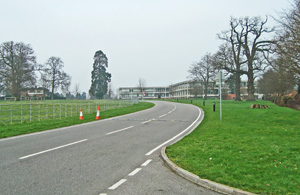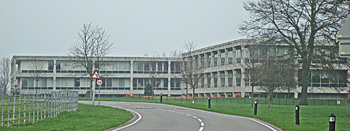Hayes Park
Hayes End Road, Hayes, Middlesex
Medical
dates:
Medical
character:
Mental (Licensed House)
In 1849 Hayes
Park became a private asylum licensed to Dr John Conolly, in
partnership with his brother Dr William Conolly, who had been
the proprietor of Castleton House, another private asylum in Cheltenham.
The large 2-storey mansion had a central porticoed doorway. It was situated in extensive grounds with a well-wooded park spread over 63 acres. The accommodation and furniture within the asylum was of a superior class to most asylums, and was available only to patients of the middle and higher ranks of society. The grounds allowed for good walks and carriages were kept for patients' use, as carriage rides were considered therapeutic.
In 1850 a new licence for 10 male and 10 female patients was granted to Dr William Conolly. When he retired in 1852, his son-in-law Charles Fitzgerald took over the licence and continued to run the asylum.
In 1859 the asylum contained 8 male and 6 female patients.
Charles Fitzgerald got into financial difficulties and was declared bankrupt in 1859. He was forced to give up the business and the licence was then taken over by Dr John Conolly and his son E.T. Conolly until 1861.
By 1867 only female patients were admitted. The asylum was licensed to Dr Edward Benbow and his wife for the reception of 18 ladies. Generally, 7 or 8 patients dined with the Benbows.
In 1874 there were 14 patients.
In 1881 Dr Henry Forbes Winslow, the Resident Medical Officer, became the joint licensee with Dr Benbow. There were 15 patients, cared for by a Matron and 8 nurses, with the staff remaining longer than in other private asylums. The Lunacy Commissioners found the accommodation and the domestic arrangements to be good. Some patients had their own apartment homes. A small detached cottage in the grounds was used for a few cases. The annual charge was, on average, about 300 shillings (£15).
In 1898 the asylum accommodated 19 patients. It closed on the death of Lord Hillingdon that same year, when the estate was broken up and sold.
The large 2-storey mansion had a central porticoed doorway. It was situated in extensive grounds with a well-wooded park spread over 63 acres. The accommodation and furniture within the asylum was of a superior class to most asylums, and was available only to patients of the middle and higher ranks of society. The grounds allowed for good walks and carriages were kept for patients' use, as carriage rides were considered therapeutic.
In 1850 a new licence for 10 male and 10 female patients was granted to Dr William Conolly. When he retired in 1852, his son-in-law Charles Fitzgerald took over the licence and continued to run the asylum.
In 1859 the asylum contained 8 male and 6 female patients.
Charles Fitzgerald got into financial difficulties and was declared bankrupt in 1859. He was forced to give up the business and the licence was then taken over by Dr John Conolly and his son E.T. Conolly until 1861.
By 1867 only female patients were admitted. The asylum was licensed to Dr Edward Benbow and his wife for the reception of 18 ladies. Generally, 7 or 8 patients dined with the Benbows.
In 1874 there were 14 patients.
In 1881 Dr Henry Forbes Winslow, the Resident Medical Officer, became the joint licensee with Dr Benbow. There were 15 patients, cared for by a Matron and 8 nurses, with the staff remaining longer than in other private asylums. The Lunacy Commissioners found the accommodation and the domestic arrangements to be good. Some patients had their own apartment homes. A small detached cottage in the grounds was used for a few cases. The annual charge was, on average, about 300 shillings (£15).
In 1898 the asylum accommodated 19 patients. It closed on the death of Lord Hillingdon that same year, when the estate was broken up and sold.
Present
status (February 2011)
In 1898 the house and 60 acres were sold for use as a psychiatric nursing home.
In 1959 the property was purchased by H.J. Heinz Co Ltd, along with two adjacent parcels of land, in order to build offices and laboratories for the company's UK Headquarters.
In 1962 the mansion was demolished and new offices built on its site.

The driveway to the Heinz corporate headquarters, which opened in 1965.

The original building was extended in 2000 and the site now provides office accommodation for several major corporations.
(Author unstated) 1882 Thirty-sixth Report of the Commissioners in Lunacy to the Lord Chancellor, Vol. 32. London, House of Commons.
Cole RH 1908 A short account of Moorcroft, past and present. Journal of Mental Science 54, 181-186.
Parry Jones WLl 2007 The Trade in Lunacy: a Study of Private Madhouses in England in the Eighteenth and Nineteenth Centuries. Abingdon, Routledge.
Scull AT 1989 Social Order/Mental Disorder: Anglo-American Psychiatry in Historical Perspective. Berkeley, University of California Press.
http://happywarrior.org
http://studymore.org
http://westlondonchat.com
https://historic-hospitals.com
www.bidwells.co.uk
www.british-history.ac.uk
www.jtrforums.com
www.peerage.org
www.rootsweb.ancestry.com
Return to home page